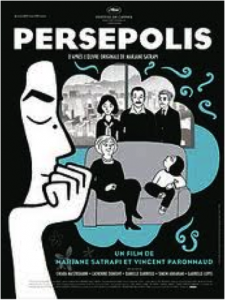By Marjane Satrapi
Originally published in French, Persepolis gained much recognition, as an autobiography, for its unique style as a graphic novel. The novel was first published as two separate books, Persepolis and Persepolis 2, now published together as one complete work of literature: ‘The story of a childhood’ and ‘The story of a return’. In 2007 the film adaptation was released, depicting the same illustrations as in the novel, in a major motion picture, in which Satrapi co-directed with Vincent Paronnaud a French comic book artist. Not only did the novel attract so much positive attention, the film also received an Oscar nomination for ‘Best Animated Feature’ at the United States Academy Award. The comic was well received in western countries, with British critics praising Satrapi’s unique approach to an autobiography in which she succeeds to completely to change Western views on Iran as she believes ‘that an entire nation should not be judged by the wrongdoings of a few extremists’.
Set in Iran, Persepolis depicts the story of Satrapi’s childhood and her struggle to live in Iran during the rise of the Islamic Revolution. The first part of the novel demonstrates a child’s education into the world she lives in and her family’s participation in the protests taking place in Iran against the inevitable war. The 10 year old Marjane often talks to God and sees herself as the last prophet in which she dreams of social equality, brought about by the law that women were forced to wear the veil and men and women were separated in every aspect of life. Satrapi portrays her struggle as a young woman who just wants to be ‘normal’ in a country where posters and designer clothes were seen as an opposition to the regime and parties had to be held in secret. Finally ‘The return’ depicts Marjane’s struggle with the separation from her family and her own personal battle with her identity, after moving from a religious Iran to an open and secular Europe. Having struggled with not only the separation from her family and home, but with a new language and a new way of life she returns home to find a country destroyed by the war with Iraq.
Satrapi outlined, in the introduction to Presopolis, that she wrote the graphic novel to demonstrate to the world that not all Iranians should be blamed for the wrong doings of the extremists. However, the graphic novel also appears to demonstrate a young Iranian woman’s struggle with her own personal identity in a foreign country and the hardships faced by the separation from her family and her own way of life. Therefore, Satrapi presents to her readers a fundamental and very relevant depiction of how an individual’s identity can be shaped, not only by the political turmoil surrounding them, but also by her own form of creative practise in the form of an autobiographical graphic novel, an integral work of literature in our society today.
Satrapi, Marjane. Persepolis. Paris: L’Association, 2003. Print.
-Louisa Grace Clark

